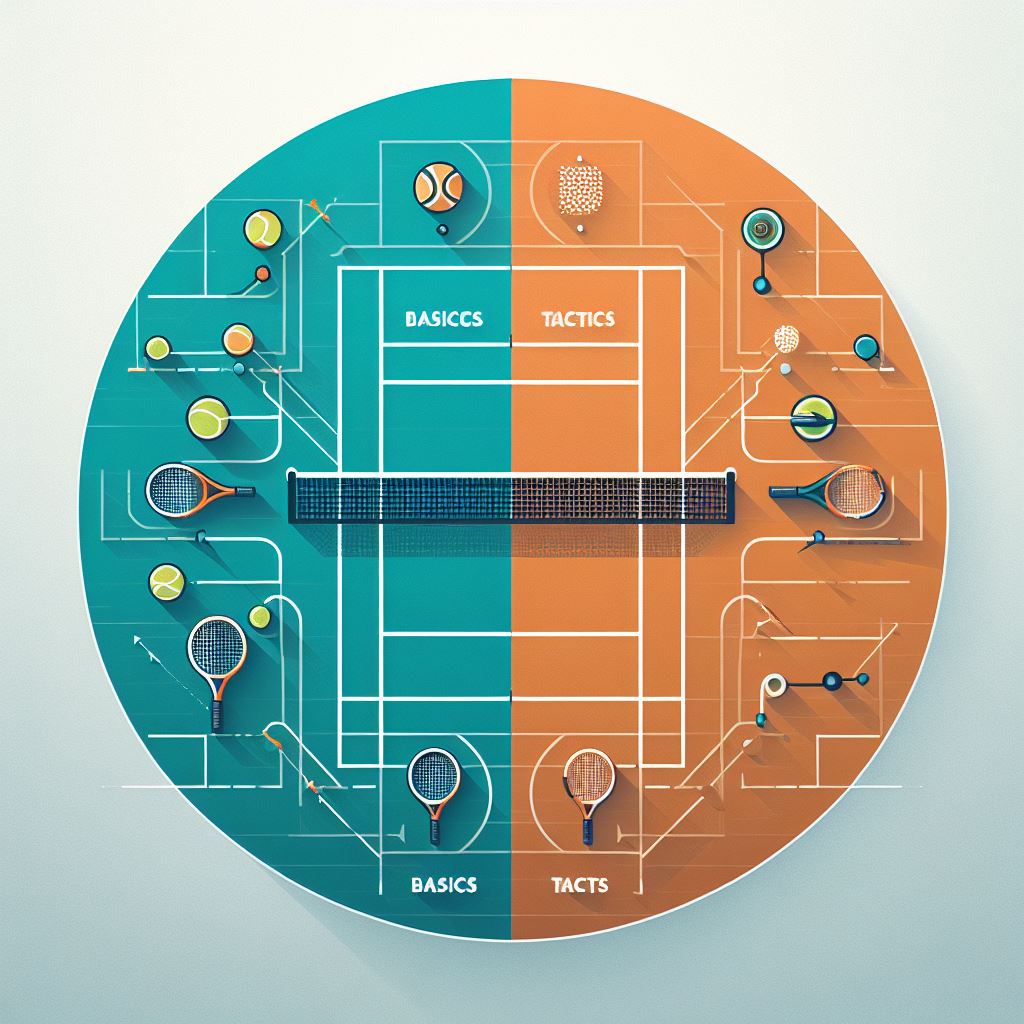In the world of tennis, the interplay between fundamental skills and strategic thinking is akin to the delicate balance between a conductor and their orchestra. Just as a conductor must possess a deep understanding of each instrument’s capabilities and harmonize them to create a symphony, a tennis player must master the basics while simultaneously orchestrating their strategic moves to outmaneuver opponents.
This article delves into the fusion of tennis fundamentals and strategies, uncovering how this harmonious blend can elevate one’s game to new heights of competitive prowess.
Key Takeaways
- Mental preparation is crucial for effective shot execution and decision-making.
- Solid understanding of fundamentals, such as footwork and technique, is essential for consistent performance.
- Strategies are vital, especially in doubles matches, to coordinate movements and exploit opponents’ weaknesses.
- Effective communication between partners is necessary for successful strategies.
Importance of Fundamentals and Strategies
Why are fundamentals and strategies crucial in the game of tennis?
The answer lies in the fact that tennis is not just a physical sport, but also a mental one. The role of mental preparation in tennis cannot be understated. Players need to be mentally focused and prepared to execute their shots effectively and make quick decisions on the court.
Without a solid understanding of the fundamentals, such as proper footwork, grip, and technique, players will struggle to execute their shots consistently and effectively.
Additionally, strategies play a vital role in the game of tennis, especially in doubles matches. Communication between partners is essential to coordinate their movements and strategies on the court. Effective communication helps players anticipate each other’s shots, cover the court efficiently, and exploit their opponents’ weaknesses.
Without proper communication, doubles partners may find themselves in awkward positions, leading to missed shots and lost points.
Enhancing Footwork and Racket Grip
Enhancing footwork and racket grip is essential for improving performance in the game of tennis.
Footwork drills are designed to improve agility, speed, and balance, all of which are crucial for a player’s ability to move efficiently around the court. These drills focus on quick changes of direction, lateral movements, and explosive starts and stops. By practicing footwork drills regularly, players can develop better footwork patterns and react faster to their opponent’s shots.
In addition to footwork, having an effective grip technique is also vital in tennis. The grip determines how a player can generate power and control the ball. There are several different grip techniques in tennis, including the Eastern grip, the Western grip, and the Continental grip. Each grip has its own advantages and disadvantages, and players should experiment to find the one that suits their playing style best.
Furthermore, maintaining a consistent grip throughout the swing is crucial for accuracy and control. A loose grip can result in mishits and loss of power, while a tight grip can restrict the player’s range of motion and lead to muscle tension. Finding the right balance between a firm and relaxed grip is key to optimizing performance.
Mastering Shot Technique for Tactical Advantage
To gain a tactical advantage in tennis, it is crucial to master shot technique, building upon the foundation of enhanced footwork and racket grip. Shot technique refers to the execution of various strokes, including forehand, backhand, volleys, and serves. When properly executed, these shots can help players gain control over the game and outsmart their opponents.
Here are key aspects to consider when mastering shot technique for a tactical advantage:
- Shot Placement:
- Understanding the court dimensions and angles is essential for accurate shot placement.
- Players must aim to strategically place shots in areas that force their opponents into difficult positions.
- By placing shots deep, wide, or short, players can exploit their opponent’s weaknesses and create opportunities to seize control of the point.
- Shot Selection:
- Different situations call for different shots, and players must learn to select the most appropriate stroke for each scenario.
- Shot selection is influenced by factors such as court position, opponent’s positioning, and the desired outcome.
- Players should consider their own strengths and weaknesses, as well as their opponent’s playing style, when choosing shots that maximize their chances of success.
Mastering shot technique requires practice, analysis, and adaptability. By consciously developing shot placement skills and understanding how to select the right stroke for each situation, players can gain a significant tactical advantage on the tennis court.
Developing Strategic Decision-Making Skills
Continuing with the exploration of tactical advantage in tennis, the next crucial aspect to consider is the development of strategic decision-making skills. In order to excel in this aspect of the game, players must analyze their opponent’s patterns and adapt their strategies based on the court surface.
Analyzing opponent’s patterns is a key component of strategic decision-making in tennis. By carefully observing the way an opponent plays, a player can identify their strengths, weaknesses, and tendencies. This allows the player to anticipate the opponent’s moves and adjust their own strategy accordingly. For example, if an opponent consistently favors one particular shot, a player can exploit this by strategically placing the ball in areas that force the opponent out of their comfort zone.
Another important factor to consider in strategic decision-making is adapting strategies based on the court surface. Different court surfaces, such as grass, clay, and hard court, affect the way the ball bounces and the overall pace of the game. By understanding the unique characteristics of each surface, players can tailor their strategies to maximize their chances of success. For instance, on a fast grass court, players may opt for aggressive, serve-and-volley tactics, while on a slow clay court, players may focus on longer rallies and precise shot placement.
Integrating Basics and Strategies for Competitive Edge
By leveraging the analysis of opponent’s patterns and adapting strategies based on the court surface, players can integrate tennis basics and strategies to gain a competitive edge. This integration involves a combination of tactical positioning and a strong mental game.
To fully integrate basics and strategies for a competitive edge, players must consider the following:
- Tactical positioning: This involves understanding the strengths and weaknesses of both the player and the opponent. By identifying patterns in the opponent’s game, players can strategically position themselves on the court to exploit weaknesses and capitalize on opportunities. Effective tactical positioning allows players to control the flow of the game and dictate the pace.
- Mental game: Tennis is not only a physically demanding sport, but also a mentally challenging one. Players must develop mental resilience and the ability to stay focused and composed under pressure. By integrating mental strategies such as visualization, positive self-talk, and mindfulness techniques, players can enhance their performance and maintain a competitive edge.
- Adaptability: The ability to adapt strategies based on the court surface is crucial for success in tennis. Different court surfaces, such as grass, clay, and hard court, require different tactics and shot selection. Players must be able to adjust their game plan accordingly to maximize their chances of winning.
Integrating tennis basics and strategies for a competitive edge requires a deep understanding of the game, careful analysis of opponents, and a strong mental approach. By incorporating these elements, players can elevate their performance and increase their chances of success on the court.
Frequently Asked Questions
How Do I Improve My Footwork and Racket Grip in Tennis?
Improving agility and perfecting grip technique are crucial aspects of enhancing footwork and racket grip in tennis. By focusing on agility training exercises and practicing proper grip technique, players can significantly enhance their performance on the court.
What Are Some Common Shot Techniques That Can Give Me a Tactical Advantage in Tennis?
Shot techniques play a crucial role in gaining a tactical advantage in tennis. By mastering techniques such as topspin, slice, and drop shots, players can strategically vary their shots to keep opponents off balance and create opportunities for winning points.
How Can I Develop Strategic Decision-Making Skills in Tennis?
Developing decision-making skills in tennis is crucial for success on the court. Strategic thinking allows players to anticipate their opponents’ moves, adapt their game plan, and make informed choices. The importance of strategy cannot be overstated in the game of tennis.
What Are Some Ways to Integrate Tennis Basics and Strategies for a Competitive Edge?
Integrating tennis fundamentals and strategies is crucial for gaining a competitive edge. By combining technique and tactics, players can maximize their potential on the court. This requires a deep understanding of the game and the ability to make strategic decisions in real-time.
Can You Provide Some Examples of How Fundamentals and Strategies Are Important in Tennis?
The importance of fundamentals and strategies in tennis can be seen through examples such as improving footwork and racket grip, utilizing shot techniques for a tactical advantage, developing strategic decision-making skills, and integrating tennis basics and strategies for a competitive edge.
Conclusion
In the world of tennis, combining the fundamentals with strategic thinking is essential for achieving a competitive edge.
By enhancing footwork and racket grip, mastering shot technique, and developing strategic decision-making skills, players can elevate their game to new heights.
Just as a skilled artist combines different colors and brushstrokes to create a masterpiece on canvas, tennis players must integrate the basics and strategies to create their own masterpiece on the court, leaving their opponents in awe of their skill and precision.








No Comment! Be the first one.